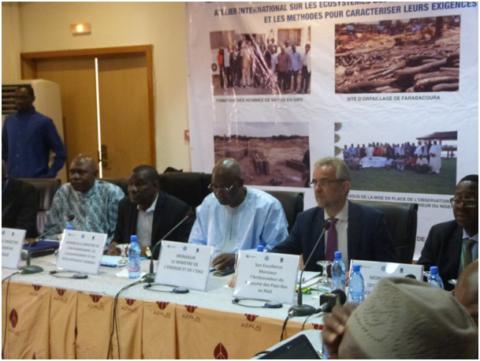The development of a participatory methodology for determining environmental flows for the Upper and Inner Niger Delta, was the purpose of the international workshop that Wetlands International Mali through the BAM-GIRE project, recently held in Bamako from 7th to 10th June 2016. The meeting was attended by leading experts and academics working on hydraulic modeling and hydrology among others thematic.

”River flows are fundamental to rivers and the hydro systems process. We must therefore establish the essential flows sustaining the delta”. Such is the statement made by Professor Lamissa Diabaté, Mali’s Secretary General of the Ministry of Energy and Water, opened the proceedings of the international workshop of rigorous methodology for determining environmental flows for the Upper Niger and the Inner Niger Delta. Pr Diabaté stressed that the need to support the establishment of such a tool for decision making is pressing because the effects of climate change and human activities are increasingly unprecedented on water resources with an increased vulnerability of people and ecosystems.
This meeting initiated by Wetlands International in Mali is part of the implementation of the Support Project to securing livelihoods and biodiversity in a changing climate, funded by the Embassy of the Kingdom of the Netherlands in Mali.
”As regards the complexity of the related social economic and environmental issues, planning and operational decisions for the Upper Niger and the Inner Niger Delta must be done with great caution, ” says Dr. Karounga Keita, National coordinator of Wetlands International Office in Mali.
We have to ensure the preservation of maximum flow rates in order to maintain the level of swamped areas, otherwise the wetlands around the delta and their ecosystems will be threatened, he added. ‘’It will also maintain an environmental flow as defined by the International Union for Conservation of Nature (IUCN) in 2008, which states that the water regime provided within a river, wetland and coastal zone to maintain ecosystems and the services they provide to people when the water uses are competitive and that the flows are regulated. To set the values of these thresholds, there is need to establish a thorough methodology for setting necessary level for a sustained delta, using the best scientific approaches and best available data, ” says Mr. Keïta.

Leading national and international experts from structures like ABN, AGRHYMET, University of Ottawa, University of Ségou, ENI-ABT, University of Kankan, WASCAL, conducting scientific research in the fields of 2D hydraulic modeling and hydrology, fish habitat, etc. and the 1st Secretary of the Netherlands Embassy in Bamako, took part in the workshop.
In the 9 countries that share the watershed of 2,170,000 km2, the Niger River sustains approximately 110 million people. Its interior Delta is the largest wetland in West Africa and the second the continent. Inside Delta ecosystems are rich in biodiversity. However, they are under pressure due to the growing exploitation of water resources, soil, flora and fauna by the local populations and industries. Vegetation cover is shrinking because of the practice of shifting cultivation, traditional gold mining, manufacture and cooking of building bricks, etc. The various forms of pollution arising from the activities of mining companies present in the area and those of Dyeing and the presence of several dams alter the hydrological regime.
In recent decades, the Inner Niger Delta has undergone significant transformations. It has gone from a largely natural system to a system increasingly modified where livelihoods and biodiversity depend heavily on land management. In addition to the impact of climate change, silting of the river bed is a threat to the hydrological regime. The health of the internal Delta, its communities and its biodiversity depends on maintaining a flow rate which, if not natural, the services balance between stakeholders.
Thus, mobilization of expertise and knowledge for the determination of environmental flows for the Niger Delta will be at several activities. The results of this workshop and subsequent activities will provide a scientific basis for setting these thresholds. This will take into account the peculiarities of the Inner Niger Delta.
The meeting allowed not only to deepen the knowledge on hydrological regimes, but also to know the methods used by the world scientific community to characterize the requirements of flood pulse in terms of water regime and also to develop knowledge in determining environmental flows.